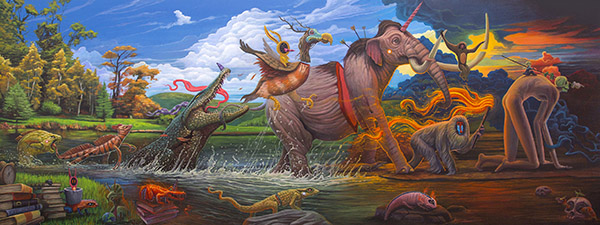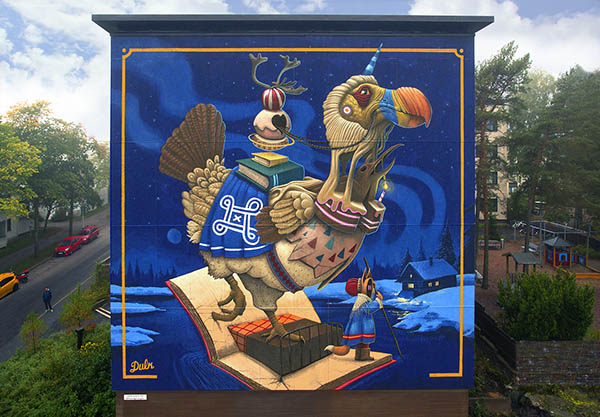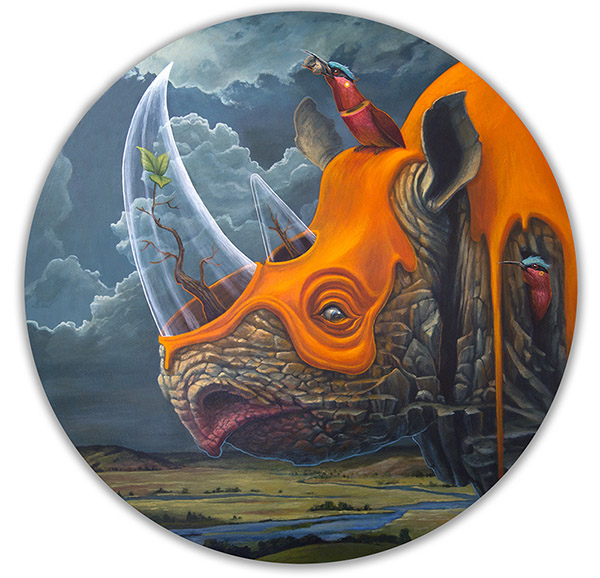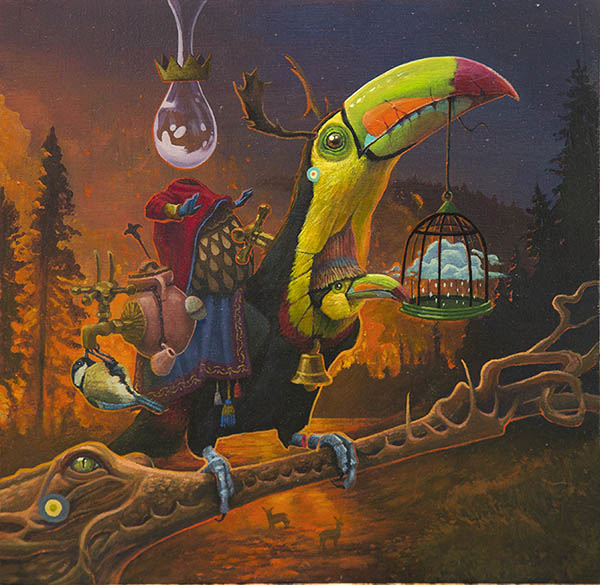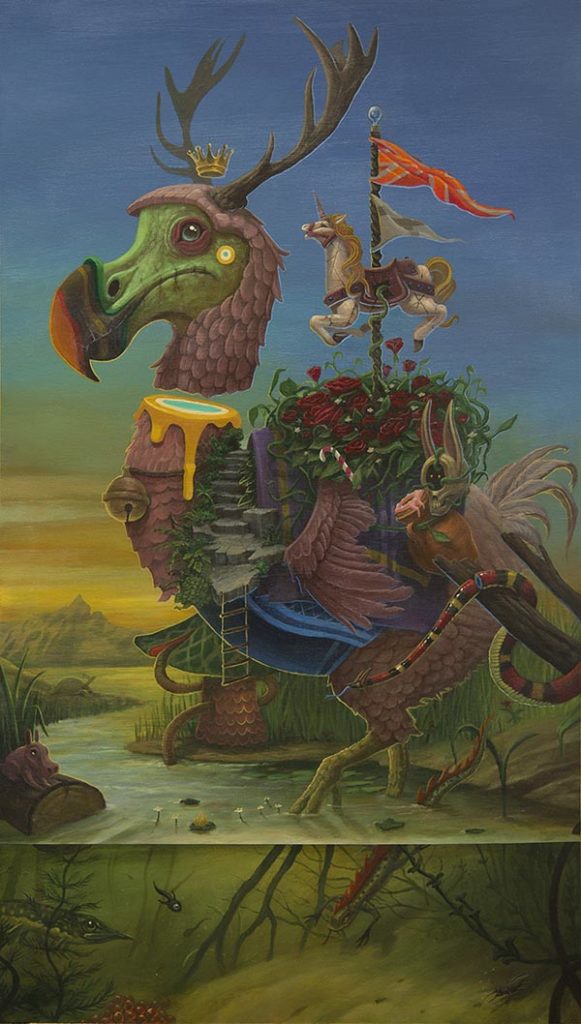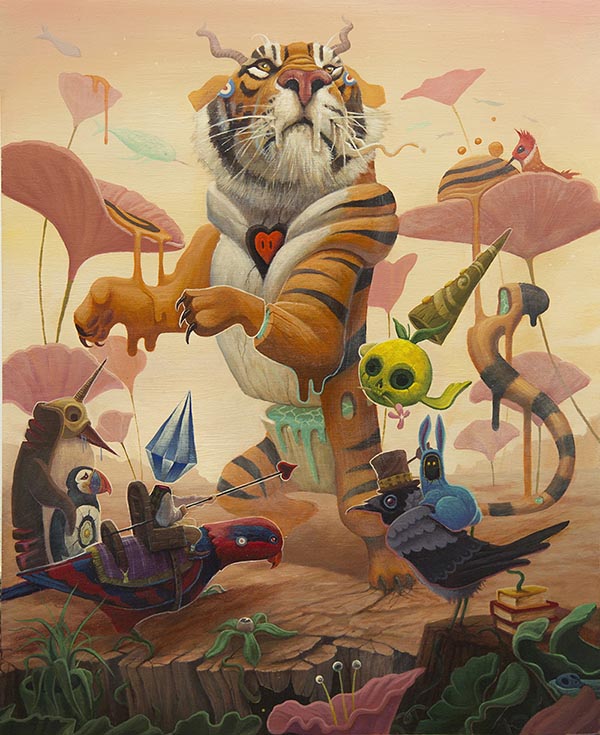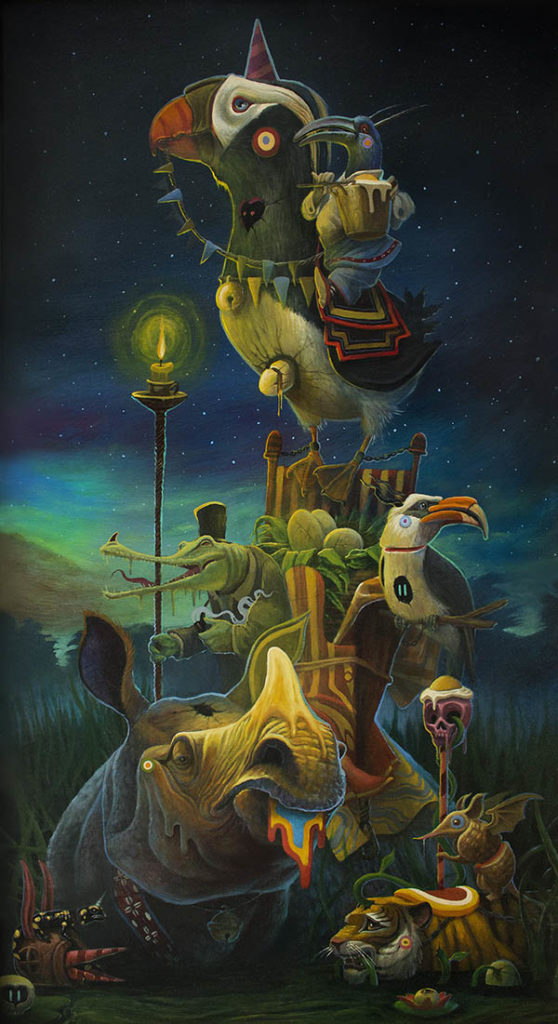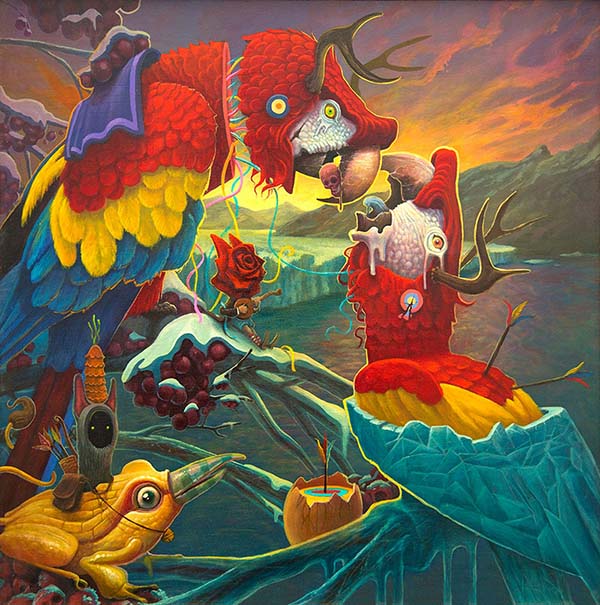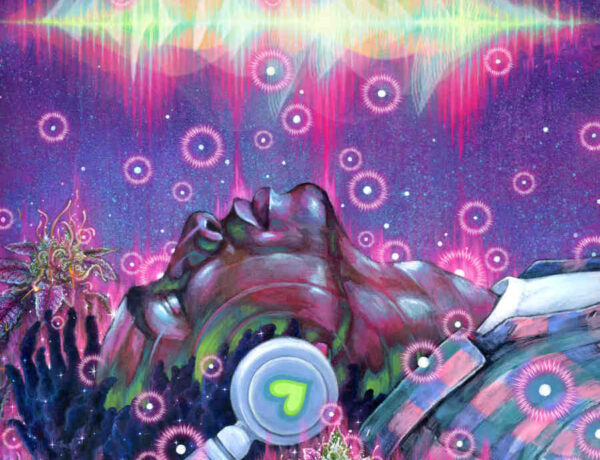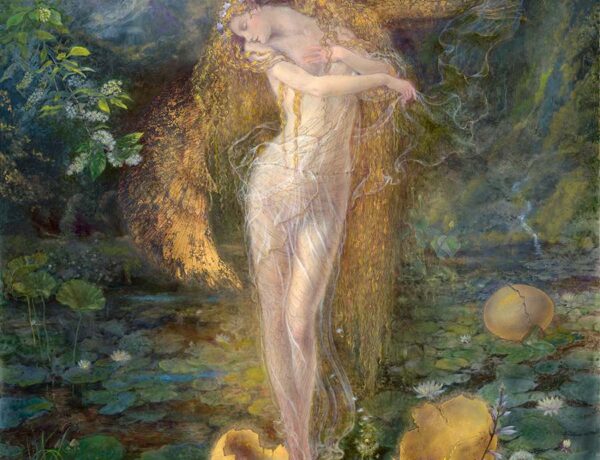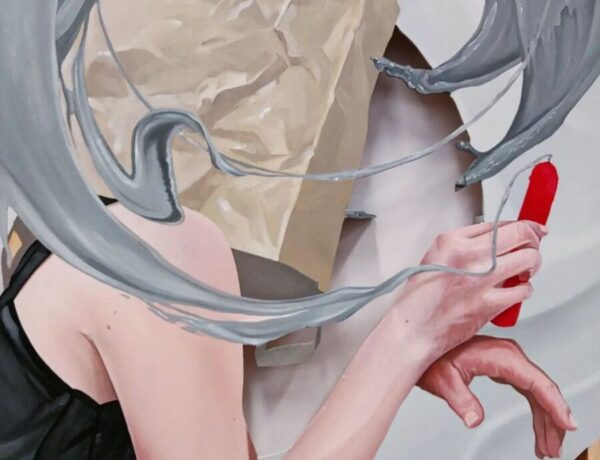One of the biggest fears becoming an adult is losing your imagination and only seeing the world as it is through dull lenses. Dulk proves this doesn’t always have to be the case by creating artworks that appear to be technically refined renderings of childhood imaginations, dreams and beliefs. He brings you on his journey of discovery, his journey to delve deep into the lives of each animal he creates and nurtures to what you see on his canvas; but some of the journey is hidden, a special moment between him and his subject that you will never be able to find no matter how hard you look.
He’s part of a movement of artists raising awareness for the world we, as human beings, are taking advantage of, “I try to capture the viewer with a nice palette in sight and then later immerse him in a tragic realism hidden in an ideal world. That’s where my work works, a mixture of reality and fiction owned by beings of nature. Frustrated ideals or dreams turned into colourful nightmares, adorned by the false reality of which the human being is nourished.”
My interview with Dulk made me fall deeper in love with his work the more we talked and the more I found out about his practice. I hope you enjoy…
“Legacy”
Thinkspace Projects, CA
Opening Reception:
Saturday, December 1, 2018 | 6:00pm – 9:00pm
Exhibition Dates:
December 1 – 29, 2018
How did you start your artistic career?
Since I was a child I remember myself drawing and painting, but my first interest in art properly came when I was nineteen years old, when I started to paint graffiti in my hometown. It changed my direction and brought me to study illustration and later graphic design in the school of art and design of Alcoi and Valencia. Since then I worked in many kinds of artistic projects as illustrator with advertising, fashion or animation designer going in parallel with the street art and constructing the basement of what I’m today.
Now I’m working as an independent artist, creating and developing my own style in the studio and in the street. Both are different disciplines, the street is more spontaneous and the studio is much more methodical, much more dedicated and where you are allowed a greater degree of control over the work. The street is exposed to all kinds of conditions much more difficult to control. However I need the side of the street to feel really free, is another part of me, it was born as a rebellious part when I started to paint walls, and is not the same already, but it is the most similar to then. It makes me excel, grow and learn. Working on big scales is a way to test yourself, to see how far I can go, and I love that.
How did you discover your style?
I have always been fascinated by encyclopedias of ancient nature and books of wildlife illustrations, fables, etc. My house was full of them when I was a child and maybe that’s why it’s part of my interest. The figure of my father as a fan of everything related to animal life, especially birds, took me to a continuous interest in following his steps and the encounter with the drawing made me wake up a feeling that even today I cannot describe. It is like uniting your two passions in one.
All my life I have drawn, all my life I have felt that need to continue and give shape to certain things that go through my head. I remember being a child and taking a paper, drawing a stage and starting here to draw its inhabitants, characters of all kinds, lots of animals, monsters and a few humans, they all mixed to form bizarre compositions. Basically, today, I’m still doing the same but with more experience. Discovering the surrealist movement and artists like Hieronymus Bosch, Dalí or Renne Magrite opened a path for me. The surrealist movement supposes the liberation of the mind, the theory of “anything goes”, the freedom of expression, without having to worry about aesthetics or morals, because it uses irrationality and even madness. Surrealism is not a technique, nor a school; it is a way of seeing and understanding reality or how to understand the reality of the dream came true.
Where do you get your inspiration from?
My style finds its basis in the organic elements, nature, and more specifically in the wildlife. About three years ago, thinking about taking the interior of my works a little further, I decided that maybe moving to the places where the characters that inspire my work really live would be a good influence. The purpose is simply to know how they live, what they eat and how they interact with the environment. The images in the internet and books are very good as a reference, but being next to a grizzly bear at 6 o’clock in the morning hiding behind some bushes with your camera waiting to get a good shot is something incredible. Three years ago I visited the African savannah in Tanzania; two years ago I was in Costa Rica, the country with the most biodiversity on the planet, and last year the Yellowstone National Park. For many it is perhaps to take simple photos, but for me it is to have been there, to have seen with your own eyes that moment, that dawn, that cold, that memory. At the time of painting, when you are in the studio sitting in front of the easel all those memories give the work a very special value. They are details that cannot be seen but they are there, and it is like freezing that moment and interpreting it your way to remember it forever as your eyes saw it. Memory is creative.
I love to create new characters and play with their anatomy but also it surprises me the way in which the human being has exercised control over everything that exists in this world and sees how we are able to break the customs of other living beings on the planet.
I try to capture the viewer with a nice palette in sight and then later immerse him in a tragic realism hidden in an ideal world. That’s where my work works, a mixture of reality and fiction owned by beings of nature. Frustrated ideals or dreams turned into colourful nightmares, adorned by the false reality of which the human being is nourished.
Happiness does not make us think; we simply enjoy or see how the people who own it enjoy it. However, sadness gives us much more to think and makes us stop and in many occasions we try to rectify situations and acts of which we feel repented, gives much more of itself.
Any past events in your life that influence your art today?
No event and all at once, clearly travel. Traveling is learning, knowing, experiencing “getting lost” in places, discovering its charm, and the secrets it has to tell us. When traveling, we learn and experience new things, many of which make us enjoy life differently than we were used to; we are able to see life with new perspectives. All this is fundamental under the vision of a creative. When I’m in Valencia, Spain [where I live], I spend a lot of time locked up in the studio so my way of escape is travel, practically always is thanks of my work, murals or exhibitions.
Traveling brings you new things, but the moment you travel to another country to contribute something as a work of art is very special. It’s like leaving your mark in a place in the sight of everyone. Street art, as its name suggests, is on the street and that brings a condition of freedom of observation to all kinds of people. At the same time, it also brings a lot of personality since it differentiates it from the other artistic aspects.
Perhaps if I had to highlight a particular work trip, it is when I was in Canada to paint a mural in the Seawalls Churchill (Manitoba) with Tré Packard (Pangeaseed Foundation) and his team. Apart from being a place that can only be reached by light plane or train, during those dates there were floods that had destroyed the train tracks so it was only reached by plane. All the materials to paint, as well as the food came in the small plane with us, we loaded the provisions ourselves. We had a couple of cranes for about 12 artists whom took turns according to needs and very little paint. I’ve been in too many festivals but the circle of friendship that was created in this place was pure magic. Painting in the cold night in summer observing the boreal aura or listening to the whales screaming while I was on top of my scaffolding were some of the things that I lived there. They joined my two passions, nature and art in its purest form to spend 15 unforgettable days. When things come up with a purpose like this, a festival does not need anything else, it does not matter if there is little painting or few means, friendship and experience is what you remember on your return home. The photo of the mural is a photo without more, it may be better or worse but what really stays inside of you is what you felt there, of who you surrounded yourself, that’s what I like the most about this.
What would you consider to be the pivotal point in your career that brought you to where you are today?
I could not highlight a particular point; rather it is the whole way that is forming this experience. I always give everything in each project and try to improve myself little by little, to contribute new things, each time a little more. Many times it is not achieved, but I always try.
I remember with great joy and satisfaction the exhibition “Broken Thoughts” in Varsi Gallery (Rome, 2015), as my first individual exhibition in an art gallery. It was the first time I was facing an exhibition project alone, four years have passed and the truth, even if it is very little time, is that I feel much more mature and prepared and that translates into the works. The need to move to nature as an observer has made me worry a lot more about showing the dream habitats and scenarios that are seen in the new collection of my next exhibition. In turn, the message is much more solid and the mysticism that I seek to generate in the inhabitants of the work is much closer to reality, thus increasing the impact on the viewer.
What would you consider to be your greatest achievement?
I do not like to anticipate the time, I like to enjoy and live every moment as if it were the last and let project proposals arrive. I would simply like to continue doing what I like most… and why not feel as though there is a child inside me but with more experience.
Your personal interest in the animals of the world shines through very brightly in your work. How do you research and design each of your works?
When proposing the concept, I am looking for a term in which I feel as comfortable as possible. There will be many hours in front of the work, therefore the more you motivate the better. Anyway, many times, the style itself, or the graphic language you use, goes to one way or another while the process progresses… but it is always good to start from a main element. From here, and with pencil and paper, I begin to sketch the whole story, creating secondary stories that interact around the main character. The result is a micro world where I discover sensations and you can lose yourself for a few minutes.
For the works of my new collection “Legacy”, I wanted to go a little further compared to my previous exhibitions. The current situation of the planet, climate change and the human impact is being something that appears every day on television, social networks, etc., is a reality, and I found it very interesting to start from here as a starting point towards a representation of a dreamlike extinction of nature that is closer. By nature, the human being avoids images of death, poaching, and spilled blood when an animal is decapitated for taxidermy purposes in the purest heroic style. These are some examples that many of us reject because it is simply unpleasant. Observing the paintings in this exhibition takes you to the same final, but in a different way.
The animals you create seem to be mutations and futuristic experimentations of the animals we know and love today. How did you come up with the idea to create ‘new’ animal?
Each time more, I base my concepts on reality to imagine. As an artist, I believe that imagination illuminates life, shows us interior worlds that we could not see without it. It makes us know ourselves and others.
In my work appear beings that physically seem different from the rest to the creatures of our world, sometimes suffer mutations, other alterations in their anatomy and thus infinite possibilities, but deep down they keep the same sensations as the fauna that surrounds us. All the characters are threatened, many times wounded and others directly dead, but presents in the soul to conform scenes full of sarcasm. I try to capture the viewer with a nice palette in sight, to later immerse him in a tragic realism hidden in an ideal world. That’s where my work works, a mixture of reality and fiction owned by beings of nature. Frustrated ideals or dreams turned into colorful nightmares, adorned by the false reality of which the human being is nourished.
To invent a character has to arise spontaneously, but then we adapt as we grow. The problem is that our culture does not assume the imaginary, but relates it to the infantile or paranoid; leaving us without the resource of the fantastic, even knowing that an invented character could not exist in real life.
The invented character achieved is the one that acquires more weight than that of its own author. This character can live all that the author has not lived or would like because real life limits him. The imaginary does not respond to any obedience, it can be created from everything; from the most monstrous to the most tender. In essence, creating a character is for immediate satisfaction, since what cannot be achieved in reality is achieved in the imaginary.
I think that inventing a character is not something from books, but before the children did it for fun. Therefore, the imagination is something essential of the human being, an inseparable part is a primary need from our beginnings.
Do each of your characters and artworks have a story?
Each story is formed from a basic idea, most of the time real, (real characters, own experiences) and from here I try to give shape to a set of elements that orbit around that root. These elements form other stories that can have multiple mini stories within the mother story. I myself create the concept about it, although not all the elements are really significant, there are some that simply happen because of themselves, from the absurd. Like the daily reality, there are facts that in some way can be more representative than others but not because of that time is stopped; the other facts continue their course. I love creating stories and consider that my work works as a free-will book in a form of a visual game. There are some elements, which you can count or dispense to form your own vision. It is clear that there is a basic concept, but from recognizing it is when the game begins to delve into the image as if you were another character, as if you entered through an imaginary door.
How long does it take you to complete one of your artworks?
It depends on many factors: complexity, format or technique. A few times more than others, but from the research phase, sketch and execution around two or three weeks.
You have a solo show coming up at ThinkSpace Gallery in December, how exciting!! I know its title ‘Extinction’. Is this the overall theme to the works you are creating for this show?
The title of this exhibition is “Legacy”. This exhibition confronts us with a fantastic world where everything flows, changes and transforms in manifold ways. That being said, the underlying discourse is unified, categorical and self-evident: man is killing nature and its incredible biodiversity, which we ought to love for many reasons. Nevertheless, we are destroying day by day, step by step. The artworks of this collection are uncompromising exhortations written in images that cry out in silence with the amplified power of 1000 words.
We come from the earth, and in these fascinating paintings everything seems to return to it. Although the earth keeps turning on its axis and keeps orbiting around the sun for our everyday lives, it is still the most solid ground base we have. In the same way, the multiple characters that swarm in the mirror-like depths of these paintings appear to be arrested, frozen and petrified.


